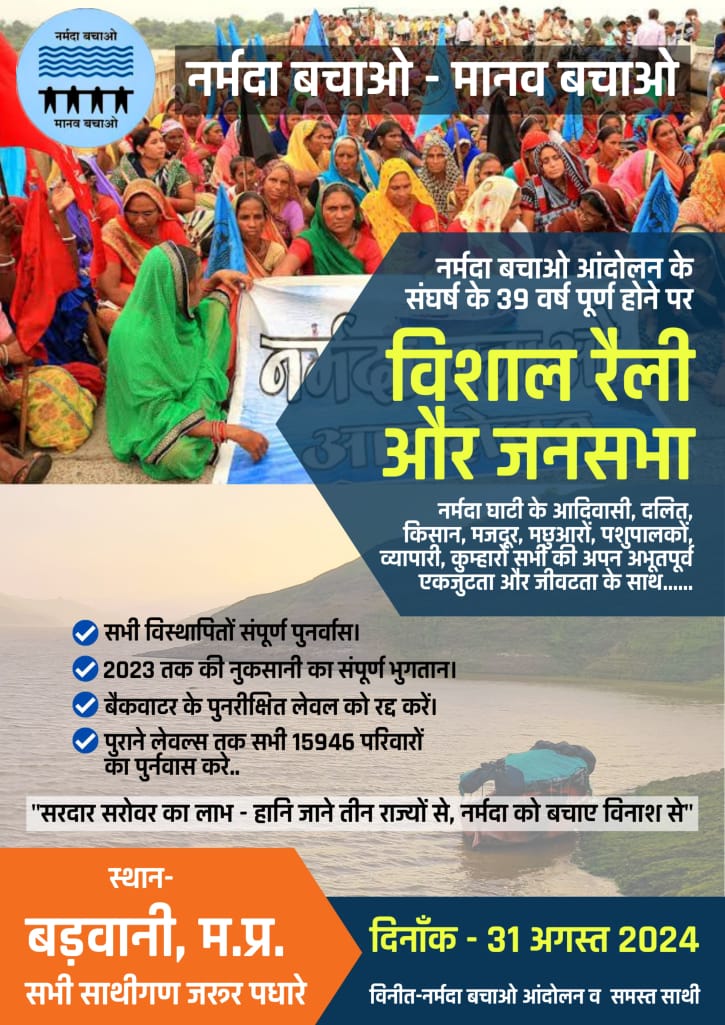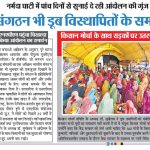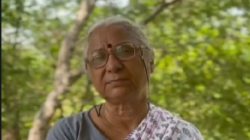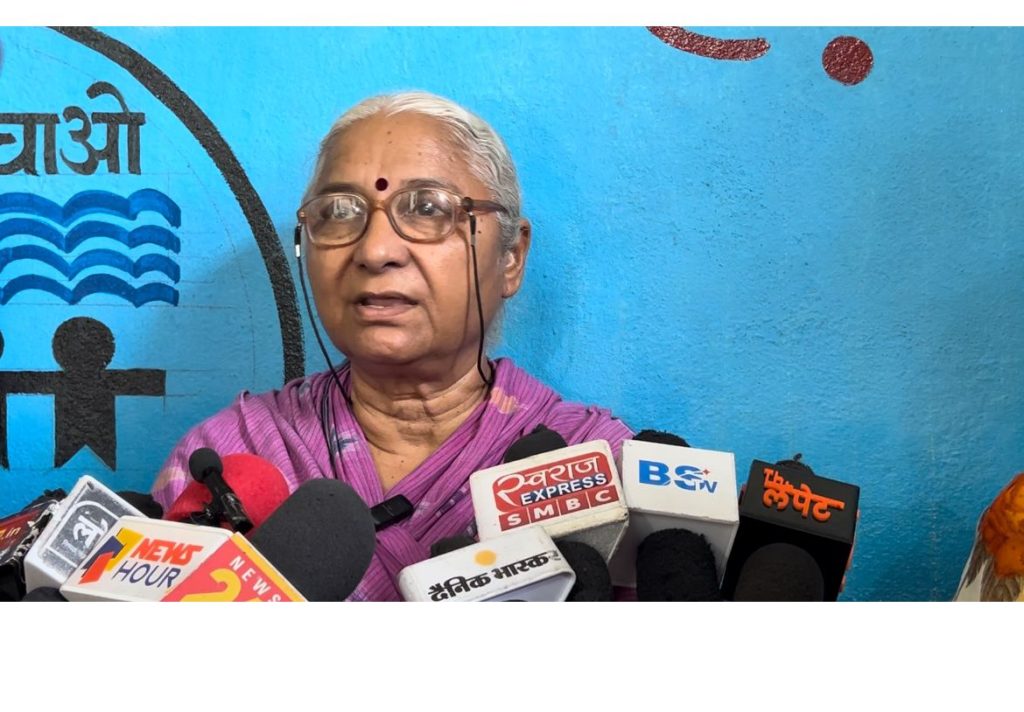An article by Ramaswamy R. Iyer, The Hindu, 13 April 2006
What the NBA is asking for is a suspension of work on the project until the prescribed conditions on resettlement and rehabilitation have been fully met in all respects.
THE DHARNA of the Narmada Bachao Andolan (NBA) and Medha Patkar’s fast give rise to many important questions. (1) Are big dams in general good or bad? (2) More specifically, is the Sardar Sarovar Project (SSP) a good project? (3) Is the SSP, as currently under implementation, in conformity with the prescribed conditions on the environmental and rehabilitation aspects? (4) If there is a failure on the rehabilitation front, is there a case for suspending construction work until that failure has been rectified, as demanded by the NBA? In particular, is the form of protest, including fasting by three persons, right, or does it amount to coercion?
(5) In a parliamentary democracy like ours, is there room for people’s movements like the NBA? Are not the people’s interests taken care of by their elected representatives in Parliament and the State Legislatures?
The first two questions will not be gone into here. Whether dams are good or bad, and whether SSP is a well-conceived project or not, it is a reality. There is a standing dam wall of 110 metres, and it seems too late to consider hypothetical alternatives in this case, though lessons can and must still be drawn from this case for the future. In the present case, we have to consider how best the dam already constructed can be put to good use, how some benefits can be extracted out of the social and human costs already incurred, how the existing injustices and hardships can be remedied and how further hardship and injustice can be avoided or minimised. As for question (5), it is clear enough that representative parliamentary democracy cannot always be presumed to be fully representative of, or responsive to, the people. Civil society initiatives, people’s movements, rallies, public interest litigation, and so on, do have a place. All this is self-evident and does not need to be argued from first principles. That leaves us with questions (3) and (4).
The NBA has been arguing that even with reference to the stage already reached by the Project, resettlement and rehabilitation are lagging badly in terms of numbers and seriously deficient in terms of conformity to conditions, the result being considerable hardship and injustice to many. To illustrate: certain steps have to be completed a year or six months (as the case may be) before submergence; there has to be land-based rehabilitation and not cash compensation; a choice (real and not illusory) of three sites for rehabilitation has to be given to the project-affected persons (PAPs); villages have as far as possible to be re-settled in clusters and not scattered far and wide; certain facilities have to be provided at the re-settlement sites; and so on. The complaint is that there are failures in regard to most of these matters.
The NBA has provided documentation to substantiate its contentions. It must be noted that it is basing its complaints on the prescriptions of the Narmada Tribunal and the judgments of the Supreme Court. The official machinery refuses to accept the NBA’s contentions. Based on official reports, the NCA has come to the conclusion that the height of the dam can be raised from 110 to 121 metres. This will add a large number to the category of PAPs, and rehabilitation will fall even further behind. What the NBA is asking for is a suspension of work on the project until the prescribed conditions on resettlement and rehabilitation have been fully met in all respects.
How can one be sure that the NBA is right and the official claims on completion of rehabilitation wrong? My answer to that question is that I have read the NBA’s documentation and find it persuasive. Many others writers, academics, activists, former civil servants, intellectuals, eminent figures in public life are also similarly persuaded. Even the new Water Resources Minister Saifuddin Soz seemed unconvinced that rehabilitation was satisfactory. D. Raja of the CPI made a public statement at the dharna site in support of the NBA’s stand. It seems clear that the official reports on the basis of which the NCA took the decision to raise the height of the dam were questionable; at any rate, the matter needs objective, independent re-examination. Pending such re-examination, the construction work must necessarily be suspended. This demand of the NBA seems entirely justified.
People in the bureaucracy are reported to have asked with real or feigned indignation: “Can we give a veto power over governmental decision-making to an individual?” That falls strangely on one’s ears. What veto power? The juggernaut is rolling heedless of protests. The Chief Minister of Gujarat is reported to have said that nothing must be allowed to stop the project. What power have the people been able to exercise? One can in fact turn that around and ask as some have done the opposite question: “Are peaceful protests ineffective? Will the state respond only to violence?” As for coercion, if fasting is coercion, so are strikes, bandhs, hartals, and other forms of protest. Unfortunately, it is the absence of response to letters, memoranda, resolutions, and even personal pleas at meetings, that drive people to such confrontational methods. If there had been early and constructive responses to Medha Patkar’s pleas she could have avoided recourse to such an extreme step. Let us note that it was only when she went on a fast and her condition started deteriorating that Ministers came to the dharna site. Who then is to blame for her decision?
After the above was written, there have been reports of Ministerial visits to the valley. We await the Ministers’ reports, hoping that they will be fair and objective and not guided by advance political instructions.
Meanwhile, one has seen an article severely critical of Medha Patkar in The Indian Express of April 10, 2006. The author finds her responsible for delaying the SSP by several years and describes her as perverse, opposed to all development, and an ideologue. The NBA’s petition to the Supreme Court led to a hiatus in the project from 1994 to 2000, and the NBA is often blamed for this six-year delay. However, when it filed its petition in 1994, did NBA ask the Supreme Court to take six years to deliver judgment? The Supreme Court could have refused to entertain the petition; it could have refused to order the suspension of work on the project; if it admitted the petition and ordered the stoppage of work, it must have found some substance in the NBA’s complaints. Having done so, it could have disposed of the case in six months instead of six years; can the responsibility for that delay be laid at the NBA’s doors? In the end, the majority judgment went against the NBA, but at least one judge found the processes of examination and clearance wanting and ordered a re-examination of the project; being a minority judgment it had no legal effect, but it showed that the NBA’s petition was not a frivolous or ill-conceived one.
Subsequently, the NBA has been drawing attention to non-compliance with conditions, violations of human rights, hardship, and so on. Faced with these things, should the NBA have kept quiet on the ground that complaints will cause delays? Should the responsibility for such delays be attributed to the complainant or to those whose omissions and commissions made the complaints necessary? Are protests against lapses “perverse”?
As for `ideology,’ it is curious that those who equate `development’ with big dams and other big projects, huge shopping malls filled with the world’s merchandise, and roads bursting with automobiles, are not described as ideologues, but those who argue that such ideas of development have brought the world to the brink of disaster and that we must pull back from the brink before it is too late, are castigated as ideologues. Ms. Patkar is not alone in holding such views; there is a worldwide groundswell of opinion that humanity must alter its ways if it and Planet Earth are to survive. There are indeed many who hold the opposite view, and they are entitled to do so; but they are not entitled to dismiss those whom they consider wrong with scorn and contempt.
In conclusion, let me put aside the attempt at academic and objective analysis, and make a declaration. The NBA is a great mass movement, one of the most important ones since independence. It and the Tehri movement have forever altered our understanding of such projects. Ms. Patkar is one of the great Indians of our time. I salute her nobility of spirit, her indomitable courage, and her steadfast commitment to the cause that she has espoused. I pray for her safe and successful emergence from the ordeal that she has undertaken.
(The writer is a former Union Secretary for Water Resources.)
Tags: development debate, NBA, resettlement and rehabilitation






